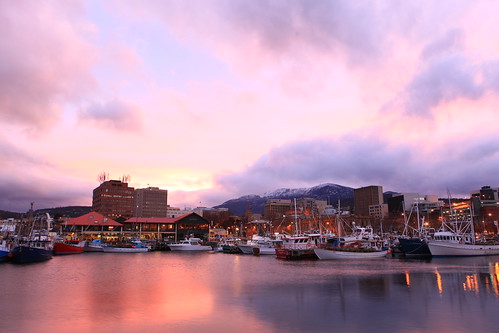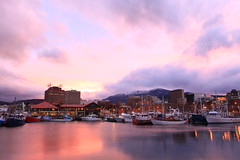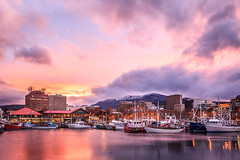Is This Photoshopped?
Ever since photoshop was invented, it has become commonplace for people to ask "Is this photoshopped" whenever they see a photo which is "too good to be true". It is sometimes annoying for photography enthusiasts to come across this question. While it may not be the actual intention, such question could be taken as an insinuation that the photographer is not as skillful as initially thought.
Just imagine a chef who's asked "Did you put MSG in?" for every nice dish he has prepared.
The fact is, I photoshop [see note] the vast majority of my photos that I publish online these days, and it is not something I need to hide.
Recently I posted a photo on social media which I was quite happy with. It was taken in Tasmanian winter from Hobart Waterfront, which is conveniently just a few minutes' walk from my residence here in this seaside town. This is my result: (yes, the "photoshopped" version)
A good friend of mine immediately asked "Is this photoshopped?". While I did not take much offence from this usual line of questioning, I was glad to use opportunity to explore the fact that photoshopping a photo is not always the same as "cheating".
This is the original, straight-out-of-camera version of the photo above:
It is already a pretty decent shot, and one that I would have been happy enough to publish in my social media. To produce this shot I had the following combination
- Weather: It's Tasmanian winter where the Mount Wellington is snow-capped (it could have been more densely capped but I might just have to try another time). The cloud has also been kind enough to not obscure the summit.
- Time: Sunset (or sunrise) is the best time to bring out the best colours of a landscape.
- Equipment: Any semi-decent camera on a tripod would have been able to produce this photo, although having a good body and a good lens probably helped produce the best quality possible for a given scene. I use Canon 5D mark II paired with Canon 24-70mm f/2.8, mounted on a sturdy tripod. It is also shot in RAW to enable the most editing flexibility.
- Composition / Location: Rule of third (with more emphasis on the sky). This is taken from a strategic spot at the Waterfront where a clear layering of the boats, town and then the mountain is formed.
- Exposure Setting: I used manual exposure (with the help of live view to get an accurate exposure). To get a smooth water I used a long-ish exposure of 0.8s (hence the absolute need for a tripod). A longer exposure would have made it even smoother; but the boat would become blurry because of the constant movements. Low ISO (for best colour and minimum noise) and medium aperture (for maximum sharpness and depth of field) are standard as per most landscape photos.
- White Balance: An important setting I went for is "shade" white balance which helps bring out the glorious warmth of a sunset. The default setting on the camera (the "auto white balance") would have gone for the cold, blue tone which is why most sunset photos taken on auto mode look drab and cold.
What I did in photoshop were:
- Cropped the photo to make it tighter
- Brought out the details of the darker area (the buildings are brightened, for example)
- Brought out the details of the brighter area (the bright area of the sky now have more texture rather than just awash with bright patch)
- Minor tweaking of the colour
- Tiny amount of vignetting (darkening of the fringe of the photo to bring attention to the middle, a common technique)
- Contrast adjustment.










0 comments:
Post a Comment